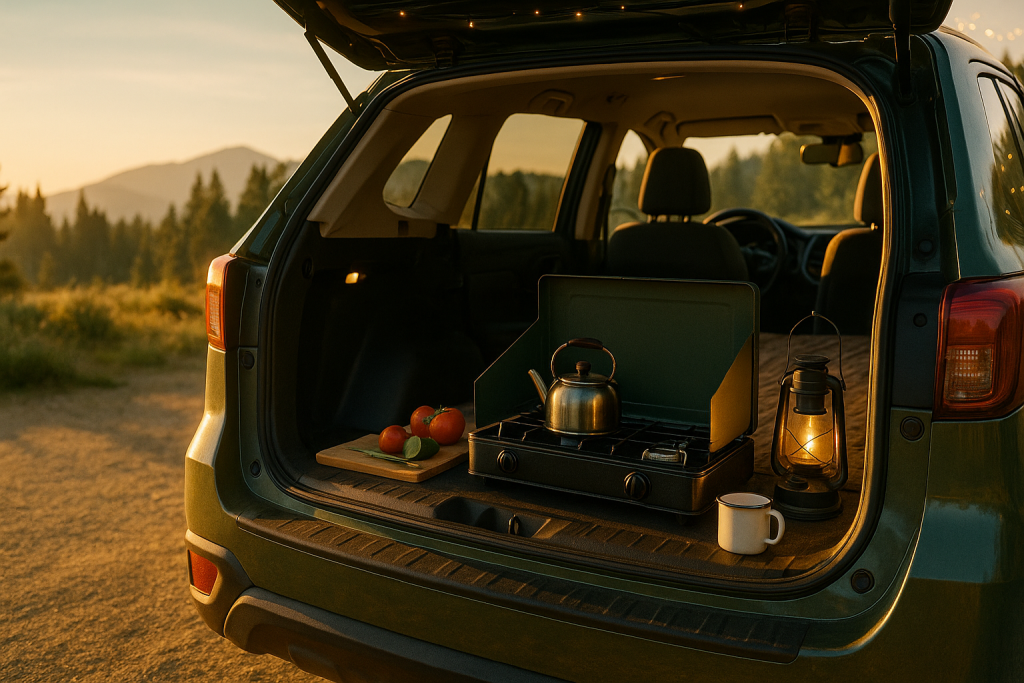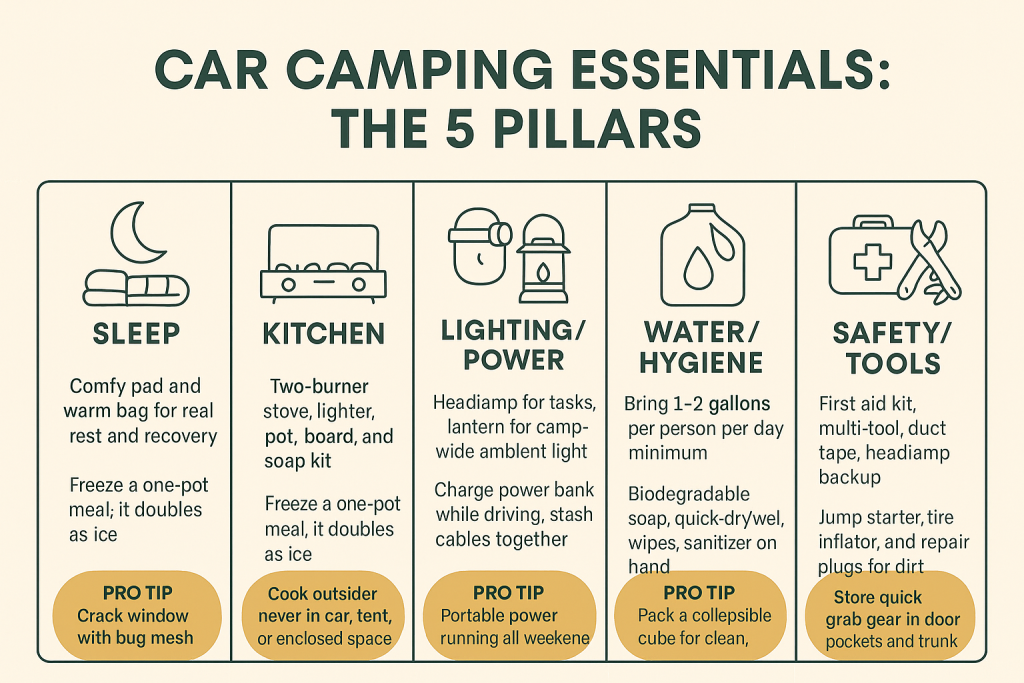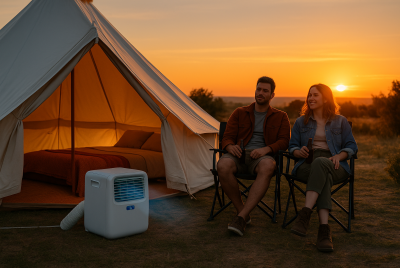Car Camping Essentials: What to Pack & Why
We may earn a commission for purchases made using our links. Please see our disclosure to learn more.
You want that perfect weekend under the stars without the stress—the “I forgot the lantern,” “why is the milk warm,” or “this air bed is definitely haunted” moments. This friendly guide covers the car camping essentials that actually make camp feel easy, comfy, and safe. You’ll walk away with a simple framework, an optional checklist, and smart gear picks (plus a quick research-backed section so you know what matters and why).
Affiliate note: I may earn from qualifying purchases at no extra cost to you.
What “car camping essentials” really means
“Essentials” aren’t everything you could bring; they’re what you reach for first—the gear that delivers safety, sleep, food, light, and comfort. Think of it like building a tiny home in your trunk: a bed (sleep system), a kitchen (stove + cooler), a living room (lighting + chairs), utilities (water + power), and a safety cabinet (first aid + tools). If you keep those pillars in mind, your car camping checklist becomes obvious and way less overwhelming.
Start with a simple plan: your vehicle, your base
Before buying anything, decide how your vehicle will act as base camp. Will you sleep inside or in a tent right next to it? Where will bins go so you can grab dinner stuff without digging past the sleeping bags? A few quick decisions now prevent nighttime chaos later.
Quick planning cues
- Measure your car’s flat sleeping length with seats folded.
- Pre-assign trunk zones: sleep, kitchen, clothing, “grab-first” safety.
- Pack in stackable storage bins and label the short sides so you can read them from the trunk.
- Keep a small “arrival kit” (headlamp, lighter, snacks) in the door pocket.
Sleep like home: mattress, pad & bedding
A good night’s sleep drives everything—mood, energy, and whether that sunrise feels magical or… optional. For sleeping pads for car camping, prioritize comfort first (thicker air bed or foam pad), then warmth (R-value if nights run cool). Top with a fitted sheet and your favorite comforter or a roomy sleeping bag. Add a real pillow. You’ll thank yourself.
Sleep system tips
- If nights dip below 50°F (10°C), bring a pad with decent insulation or add a thin foam topper under your air bed.
- Crack a window (with bug mesh) for ventilation and to reduce condensation.
- Keep a beanie and warm socks handy; they weigh nothing and fix so many chilly night issues.

Food, cooking & kitchen flow
You don’t need a gourmet setup. One camp stove, a lighter, compact cookware, a cutting board, and a sponge kit will handle 90% of meals. Keep oils, salt, spices, and hot sauce in a tiny pouch. A medium cooler for car camping with block ice keeps perishables safe; store raw meat in a leakproof container and eat it early in the trip.
Make it easy
- Prep and freeze a one-pot meal at home (chili, curry, or pasta sauce). It doubles as ice in the cooler and becomes dinner night one.
- Use one bin for the “kitchen”: stove, fuel, pot/pan, utensils, soap, trash bags, paper towels.
- Pack a picnic table cover or a silicone mat—instant clean workspace.
Power & lighting that just works
At minimum, bring a headlamp and a lantern. A compact portable power station (or at least a high-capacity power bank) keeps phones, cameras, and lights running without idling your car. Keep cables coiled in a small pouch so you’re not untangling wires in the dark.
Good habits
- Charge everything while you drive to camp.
- Assign one lantern for the “kitchen” and one for inside the tent/car.
- Keep a tiny flashlight on your keychain for late-night trips.
Water, hygiene & waste (the unglamorous MVPs)
Bring at least 1–2 gallons (4–8 L) per person per day if your site doesn’t have potable water. A collapsible water cube, biodegradable soap, a quick-dry towel, and a simple hygiene pouch (toothbrush, wipes, hand sanitizer) cover most needs. Add a small “leave no trace” waste plan: heavy-duty trash bags, zipper bags for micro-trash, and a trowel if you’ll camp where restrooms are absent.
Safety & readiness: first aid, tools, recovery
A first aid kit, multi-tool, duct tape, and a compact battery jump starter can turn a near-disaster into a mild hiccup. If your campsite is down a dirt road, add a tire repair kit, portable inflator, and a folding shovel. Keep emergency water and a reflective blanket in the car year-round.
Pack where you can reach it
- First aid & headlamp in the door pocket.
- Jump starter in the glove box or front bin.
- Bear spray or bug spray by the trunk latch (depending on region).

Organize to relax (bins, bags & a “landing zone”)
Use two or three stackable bins for car camping gear and a soft duffel for clothes. Hang a small mesh “landing zone” near the trunk for keys, wallet, and headlamp so they never go missing. Bring two extra tote bags—one becomes a laundry bag on day two, like clockwork.
Clothing & comfort: weather-ready layers
Layers beat single heavy items. Add a windproof shell, warm midlayer, breathable base, cozy socks, and a beanie. Toss in compact camp slippers or sandals for 3 a.m. bathroom runs. If temps swing, pack a light blanket for fireside hangs.
Navigation & picking a great campsite
Even with car camping, location matters. Check road conditions, fire restrictions, and nearby water. If you’re new to choosing a spot, read this campsite-picking guide on Camp Nestle for friendly, step-by-step advice that helps you spot level ground, manage wind, and find shade: how to pick a campsite.
Fire, stoves & comfort the safe way
Keep stoves on a stable, nonflammable surface and store fuel upright. On burn-ban days, shift to no-flame meals (wraps, salads, pre-cooked grains) and lean on your lantern for ambience. A packable camp chair changes everything—your back, your mood, your desire to linger under the stars.
Cooler strategy & easy breakfasts
Block ice lasts longer than cubes; use both. Separate drinks from food if you can (fewer open/close cycles). Breakfast is your simplest meal: overnight oats, burritos pre-wrapped in foil, or yogurt + granola + fruit. You’ll spend less time cooking and more time watching the sky wake up.
Leave No Trace, even at a drive-in site
Car camping still impacts the land. Stick to established sites, keep noise respectful, pack out every crumb, and store food securely. Teach kids to do a “micro-trash hunt” before you leave—turn it into a game. The campsite looks better than you found it, and that ripple matters.
Troubleshooting: tiny issues that feel big at night
- Too cold? Add a foam pad under your air mattress, wear a beanie, and sip something warm.
- Can’t find things? Create that “landing zone” at the trunk for keys/headlamp.
- Mosquitoes relentless? Bring a head net and a small fan; moving air discourages them.
- Windy cooking? Shield your stove or cook in the lee side of your vehicle (safely, outdoors).
- No level spot? Park with your head slightly uphill; a folded towel under hips helps on slopes.
🔹 Amazon Picks: 5 Car Camping Essentials We Love
1) Coleman Triton+ 2-Burner Propane Camping Stove with InstaStart Ignition Amazon
Why it’s great: Classic two-burner control in a compact, trunk-friendly body—boil coffee on one side, simmer eggs on the other.
Features
- Up to 22,000 BTUs total, adjustable burners
- Wind guards, easy wipe-down surface
Pros: Reliable, widely available fuel, packs flat.
Cons: Heavier than single-burner options; wind can still steal heat.
Best for: Couples/families who want real cooking control.
Review snapshot: Praised for even heat and simple setup; occasional notes about wind and the importance of a stable surface.
2) Anker 521 Portable Power Station (LiFePO4, 256Wh, 300W) Amazon
Why it’s great: A compact portable power station for lights, phones, cameras, and small devices—no idling the car.
Features
- 256Wh capacity, 300W output (peak 600W), USB-C PD
- Long-life LiFePO4 battery chemistry
Pros: Durable cells, multiple ports, camp-friendly size.
Cons: Not meant for high-draw appliances; adds a few pounds to the bin.
Best for: Weekend car campers who want reliable off-grid charging.
Review snapshot: Loved for longevity and port variety; some wish for faster AC recharge.
3) NOCO Boost Plus GB40 1000A UltraSafe Jump Starter Amazon
Why it’s great: The tiny box that can save a trip. It jump-starts up to 6.0L gas/3.0L diesel and doubles as an emergency power bank.
Features
- 1000A peak, reverse-polarity and spark protection
- Built-in flashlight, USB charging
Pros: Peace of mind in a glove box; simple to use.
Cons: Needs occasional top-off charging; not a tire inflator.
Best for: Anyone leaving pavement or camping in colder temps.
Review snapshot: Tons of happy saves; common tip is to charge it monthly.
4) Lightspeed Outdoors Deluxe 2-Person PVC-Free Air Bed Amazon
Why it’s great: Car-sized comfort without PVC smell, and it fits in many SUVs/wagons.
Features
- 79″ x 57″ x 8″ inflated, ~6.5 lb
- Battery-operated pump include
Pros: Roomy, comfy, packs smaller than many air beds.
Cons: Like all air beds, temperature swings can change firmness; bring a foam topper if it’s cold.
Best for: Couples or solo campers who want mattress-like comfort.
Review snapshot: Appreciated for comfort and easy inflation; a few note better performance on a protective ground/tent floor or with a thin foam layer for insulation.
5) BioLite AlpenGlow 500 Lantern Amazon
Why it’s great: A bright, cozy lantern with fun ambient modes and a built-in power bank for phones.
Features
- Up to 500 lumens, USB-rechargeable
- Multiple color/scene modes, hanging loop
Pros: Great area light, doubles as mood lighting, power-bank function.
Cons: Pricier than basic lanterns; charge it before weekend trips.
Best for: Camps that double as hangout spaces.
Review snapshot: Reviewers love the glow and runtime; occasional wish for an even tougher body for rough trips.
Quick Comparison Table
| Model | Key Spec(s) | Warranty | Approx Price/Tier | Best For |
| Coleman Triton+ 2-Burner Stove | 22,000 BTUs, wind guards, 2 burners | Limited manufacturer | $$ mid | Real cooking control |
| Anker 521 Power Station (256Wh) | 300W (600W peak), LiFePO4, USB-C PD | Often 5-year on LiFePO4 (check listing) | $$ mid | Weekend device power |
| NOCO Boost Plus GB40 | 1000A jump, flashlight, power bank | 1-year+ (check listing) | $$ mid | Emergency readiness |
| Lightspeed 2-Person Air Bed | 79″ x 57″ x 8″, PVC-free, pump incl. | 1-year (check listing) | $$ mid | Car-sleep comfort |
| BioLite AlpenGlow 500 | 500-lumen lantern, USB-rechargeable | 1-year+ (check listing) | $$ mid/high | Bright, cozy lighting |
(Approx tiers vary by seller and season. Always confirm current specs and warranties on the product page.)

🧪 Research-Backed: why these essentials matter
- Food safety is real at camp. The CDC estimates that 48 million people get sick from foodborne illness in the U.S. each year—so keeping perishables at safe temperatures and avoiding cross-contamination truly matters. See the CDC’s overview in “About Food Safety” (2024) for the core clean-separate-cook-chill practices.
- Warm sleep is about insulation, not just blankets. The R-value of your pad is a measurable way to keep heat from escaping to the ground; higher R-value equals more warmth. REI’s “Sleeping Pad Buying Guide” (2025) explains how R-values add together if you stack pads—handy on shoulder-season nights. I
- Stove safety is non-negotiable. The CDC’s carbon monoxide guidance (updated 2024) explicitly warns to never use a gas camp stove in enclosed spaces. Carbon monoxide can kill quickly without odor or warning. Always cook outside with ventilation.
FAQs
How many car camping essentials do I actually need for a weekend?
Focus on the pillars: sleep, food, light, water, safety, and organization. For two people, one bin for kitchen, one for sleep gear, and a small safety pouch covers most trips. Add clothing layers and a cooler; you’re set.
What size cooler should I bring for 2–3 days?
A mid-size (35–45 qt) cooler works for two people if you pre-chill it, use block ice + cubes, and keep drinks separate when possible. Pack raw meat in a leakproof container and eat it first.
Is a portable power station necessary?
Not strictly—but it’s a quality-of-life upgrade. It powers lights, phones, cameras, and inflators without idling your car. If you shoot photos, use GPS a lot, or work remotely, it quickly becomes a “why didn’t I do this earlier?” purchase.
Can I sleep in my car without fancy gear?
Absolutely. A foam pad or air bed, real pillow, and a warm blanket/sleeping bag make a huge difference. Vent the window slightly with a bug screen and crack the trunk for airflow if it’s safe to do so.
What’s the one thing people forget?
Two, actually: a second headlamp (so each person has one) and paper towels (for everything). Honorable mentions: extra trash bags and a lighter that actually lights.
Wrap-up: build your kit once, relax every trip
When you build your kit around these car camping essentials, every trip gets easier: faster setup, warmer sleep, safer cooking, less fumbling in the dark. Start with the pillars, pack in bins, and add one upgrade each trip (a better light, a comfier bed, a tidy kitchen tool). You’ll feel the difference on day one—and even more on that crisp, golden morning when the coffee hits just right.
See you out there. And if you’re picking your next spot, don’t forget to skim Camp Nestle’s campsite tips linked above—tiny choices make big comfort.




